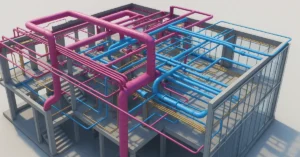Exploring Brutalist Buildings in São Paulo
São Paulo is a metropolis known for its diverse and avant-garde architecture. Among its many styles, Brutalist architecture holds a significant place, shaping the city’s urban landscape with its raw concrete aesthetics, bold geometric designs, and functionalist approach. This architectural movement, which flourished in the mid-20th century, found a unique expression in São Paulo, influencing both public and private spaces. In this guide, we explore the city’s most remarkable Brutalist buildings and their significance.
What is Brutalist Architecture?
Brutalism is an architectural style that emerged in the mid-20th century, emphasizing the use of raw concrete, geometric forms, and minimal ornamentation. The term “Brutalism” is derived from the French phrase “béton brut,” meaning “raw concrete.” This style became particularly popular in Brazil, where architects merged it with the country’s modernist principles to create striking and functional structures.
São Paulo’s Must-See Brutalist Buildings
1. São Paulo Museum of Art (MASP)
Location: Avenida Paulista, 1578, São Paulo, SP, Brazil
Architect: Lina Bo Bardi
Year: 1968
One of the most iconic Brutalist buildings in São Paulo, MASP is a masterpiece of modern architecture. Its massive concrete structure is suspended by bright red pillars, creating an open space beneath the museum. This innovative design allows for public gatherings while showcasing the power of exposed concrete, a hallmark of Brutalist architecture.
2. Faculty of Architecture and Urbanism, University of São Paulo (FAU-USP)
Location: Rua do Lago, 876, São Paulo, SP, Brazil
Architect: João Batista Vilanova Artigas
Year: 1969
FAU-USP is a Brutalist landmark designed to foster creativity and academic interaction. Its monolithic concrete form, open interiors, and minimal ornamentation highlight the raw aesthetic of Brutalism. The exposed structural elements serve both functional and artistic purposes, making it one of the most influential academic buildings in Brazil.
3. SESC Pompeia
Location: Rua Clélia, 93, São Paulo, SP, Brazil
Architect: Lina Bo Bardi
Year: 1982
SESC Pompeia is a cultural and recreational center that perfectly embodies Brutalist principles. Featuring rough concrete towers connected by sky bridges, the structure creates a dynamic interplay of light and shadow. Its industrial aesthetic, repurposed from an old factory, showcases the adaptability of Brutalist architecture.
4. Copan Building
Location: Avenida Ipiranga, 200, São Paulo, SP, Brazil
Architect: Oscar Niemeyer
Year: 1966
While often associated with modernism, the Copan Building also displays Brutalist characteristics. Its massive concrete facade and sweeping curves define the city’s skyline, offering a bold example of how Brutalist elements can be integrated into large-scale residential projects.
5. Edifício Louveira
Location: Rua Piauí, 1081, São Paulo, SP, Brazil
Architect: João Batista Vilanova Artigas
Year: 1946
This residential building is one of the earliest examples of Brutalism in São Paulo. Its raw concrete exterior, open balconies, and practical layout reflect the principles of functionality and honesty in design, which later became trademarks of the Brutalist movement.
The Influence of Brutalism on São Paulo’s Urban Landscape
Brutalism in São Paulo was not just an architectural style but a response to the city’s rapid urbanization. The use of concrete allowed for the construction of large, durable structures that could accommodate the city’s growing population and expanding cultural institutions. Many of these buildings were designed with social interaction in mind, incorporating open spaces and communal areas.
Preservation vs. Demolition: The Debate Over Brutalism
Despite their architectural significance, many Brutalist buildings in São Paulo face threats of demolition due to changing aesthetic preferences and urban renewal projects. Some structures have been repurposed, while others remain in a state of neglect. Preservationists argue that these buildings are essential to the city’s architectural identity and should be maintained rather than replaced.
Why You Should Appreciate Brutalism in São Paulo
Brutalist buildings may not conform to traditional beauty standards, but they tell an important story about São Paulo’s growth and architectural innovation. Their bold designs, functional layouts, and raw materiality create a unique urban experience. Exploring these structures allows you to appreciate the vision and creativity behind their construction.
For architecture lovers, a tour of São Paulo’s Brutalist landmarks offers a deeper understanding of the city’s evolution. Whether visiting museums, educational institutions, or residential complexes, you’ll witness the enduring impact of Brutalist architecture on São Paulo’s landscape.
Final Thoughts
Brutalist buildings in São Paulo stand as powerful symbols of architectural experimentation and urban development. While some may find their aesthetics harsh, their influence on modern architecture is undeniable. Whether you admire them for their structural ingenuity or their cultural significance, these buildings are an essential part of São Paulo’s identity. Take the time to explore them and discover the raw beauty of Brutalist architecture in Brazil’s largest city.
If you’re interested in learning more about architecture firms in Europe, check out this comprehensive list of the top 50 firms compiled by Archgyan. From innovative startups to long-established industry leaders, this list has it all. Take a look and discover some of the most inspiring and influential architecture firms in Europe today.
If you’re interested in architecture and want to learn more about this amazing field, subscribe to our podcast on youtube
For more SketchUp tutorials, head to https://www.sketchupguru.com










